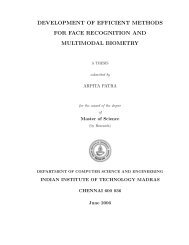The Enigma of Group Theory - Department of Computer Science ...
The Enigma of Group Theory - Department of Computer Science ...
The Enigma of Group Theory - Department of Computer Science ...
You also want an ePaper? Increase the reach of your titles
YUMPU automatically turns print PDFs into web optimized ePapers that Google loves.
http://www.cs.bris.ac.uk University <strong>of</strong> Bristol, <strong>Department</strong> <strong>of</strong> <strong>Computer</strong> <strong>Science</strong><br />
At this point we can check whether our assumption <strong>of</strong> no-stepping, i.e. a constant value for the values <strong>of</strong><br />
i2 and i3 is valid. If a step did occur in the second rotor then the above permutations would be unlikely<br />
to have the same cycle structure.<br />
We need to determine the structure <strong>of</strong> the permutation α, this is done by looking at the four equations<br />
simultaneously. We note that since σ and α are conjugates, under ρ1, we know that α has cycle structure<br />
<strong>of</strong> a single cycle <strong>of</strong> length 26.<br />
In our example we only find one possible solution for α, namely<br />
α = (AGYWUJOQNIRLSXHTMKCEBZVPFD).<br />
To solve for ρ1 we need to find a permutation such that<br />
We find there are 26 such solutions<br />
α = ρ1 · σ −1 · ρ1 −1 .<br />
(AELTPHQXRU)(BKNW)(CMOY)(DFG)(IV)(JZ)<br />
(AFHRVJ)(BLU)(CNXSTQYDGEMPIW)(KOZ)<br />
(AGFIXTRWDHSUCO)(BMQZLVKPJ)(ENY)<br />
(AHTSVLWEOBNZMRXUDIYFJCPKQ)<br />
(AIZN)(BOCQ)(DJ)(EPLXVMSWFKRYGHU)<br />
(AJEQCRZODKSXWGI)(BPMTUFLYHVN)<br />
(AKTVOER)(BQDLZPNCSYI)(FMUGJ)(HW)<br />
(AL)(BR)(CTWI)(DMVPOFN)(ESZQ)(GKUHXYJ)<br />
(AMWJHYKVQFOGLBS)(CUIDNETXZR)<br />
(ANFPQGMX)(BTYLCVRDOHZS)(EUJI)(KW)<br />
(AOIFQH)(BUKX)(CWLDPREVS)(GN)(MY)(TZ)<br />
(APSDQIGOJKYNHBVT)(CX)(EWMZUL)(FR)<br />
(AQJLFSEXDRGPTBWNIHCYOKZVUM)<br />
(ARHDSFTCZWOLGQK)(BXEYPUNJM)<br />
(ASGRIJNKBYQLHEZXFUOMC)(DT)(PVW)<br />
(ATE)(BZYRJONLIKC)(DUPWQM)(FVXGSH)<br />
(AUQNMEB)(DVYSILJPXHGTFWRK)<br />
(AVZ)(CDWSJQOPYTGURLKE)(FXIM)<br />
(AWTHINOQPZBCEDXJRMGV)(FYUSK)<br />
(AXKGWUTIORNP)(BDYV)(CFZ)(HJSLM)<br />
(AYWVCGXLNQROSMIPBEF)(DZ)(HK)(JT)<br />
(AZEGYXMJUVD)(BF)(CHLOTKIQSNRP)<br />
(BGZFCIRQTLPD)(EHMKJV)(NSOUWX)<br />
(ABHNTMLQUXOVFDCJWYZG)(EISP)<br />
(ACKLRSQVGBITNUY)(EJXPF)(HOWZ)<br />
(ADEKMNVHPGCLSRTOXQW)(BJY)(IUZ)<br />
<strong>The</strong>se are the values <strong>of</strong> ρ1 · σi , for i = 0, . . . , 25.<br />
So with one days messages we can determine the value <strong>of</strong> ρ1 upto multiplication by a power <strong>of</strong> σ.<br />
<strong>The</strong> Polish had access to two months such data and so were able to determine similar sets for ρ2 and<br />
ρ3 (as different rotor orders are used on different days). Note, at this point the Germans did not use a<br />
selection <strong>of</strong> three from five rotors.<br />
If we select three representatives ρ1, ˆ ρ2 ˆ and ρ3, ˆ from the sets <strong>of</strong> possible rotors, then we have<br />
ρ1 ˆ = ρ1 · σ l1 ,<br />
ρ2 ˆ = ρ2 · σ l2 ,<br />
ρ3 ˆ = ρ3 · σ l3 .<br />
However, we still do not know the value for the reflector ϱ, or the correct values <strong>of</strong> l1, l2 and l3.<br />
Any one <strong>of</strong> these versions <strong>of</strong> ˆρi will give a valid <strong>Enigma</strong> machine (with a different reflector). So it<br />
does not matter which choice we make for ρi,<br />
12










